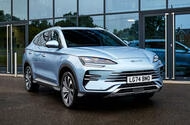Chinese car manufacturers are making waves in the UK’s plug-in hybrid electric vehicle (PHEV) market, shaking up the traditional dominance of established brands like Volkswagen and Ford. Last month, the BYD Seal U and Jaecoo 7 SUVs topped the sales charts, marking a significant shift in consumer preferences and market dynamics.
How Did Chinese Brands Capture the PHEV Market?
In May, the BYD Seal U led the charge with 1,576 sales, closely followed by the Jaecoo 7 at 1,346 units sold. This surge in popularity is backed by data from Jato Dynamics, which highlights a broader trend across Europe. Chinese PHEV sales skyrocketed by 421% in the first four months of the year, capturing 8.3% of the PHEV market. This growth is particularly impressive given the limited number of models available from Chinese manufacturers.
What’s Driving This Shift?
The appeal of Chinese PHEVs lies in their competitive pricing, impressive electric-only ranges, and generous standard features. For instance, the BYD Seal U starts at £33,315 and boasts an official electric range of 50 miles, while the Jaecoo 7 offers a 56-mile range at a starting price of £35,165. In comparison, the cheapest Volkswagen Tiguan PHEV, which also has a 75-mile range, costs a staggering £42,665—35% more than its Chinese counterparts.
This pricing strategy has resonated with cost-conscious buyers, especially fleet operators, who account for 70% of the UK’s PHEV market. The low CO2 emissions of these vehicles also translate to lower Benefit-in-Kind (BIK) tax ratings, making them even more attractive to businesses.
What’s Next for Chinese PHEVs in Europe?
Chinese manufacturers are not resting on their laurels. BYD plans to expand its European lineup with two additional models, including the anticipated Seal 06 estate. Meanwhile, Jaecoo’s parent company, Chery, is gearing up to introduce a range of new PHEV models, including the Omoda 5 and Omoda 7, as part of a strategic shift away from traditional internal combustion engine vehicles.
The competitive landscape is heating up, with Chery also set to launch PHEVs in its Tiggo SUV range and the new Lepas budget SUV brand. These vehicles will utilize the T1X platform, which incorporates Chery’s Super Hybrid drivetrain, promising enhanced performance and efficiency.
Are PHEVs Here to Stay?
Despite the impressive growth, PHEVs have faced scrutiny, particularly regarding the discrepancies between laboratory CO2 emissions figures and real-world performance. Critics argue that some consumers treat PHEVs as “fake electric cars,” primarily for their tax benefits rather than genuine environmental advantages. However, new regulations are pushing manufacturers to enhance battery sizes and electric ranges, aiming to bridge this gap.
The competition in China is fierce, leading to significant advancements in electric drivability. For example, the MG HS PHEV features an electric motor rated at 209bhp, surpassing its petrol counterpart, encouraging drivers to rely more on electric power.
What Innovations Are on the Horizon?
Chinese manufacturers are also investing in innovative battery technologies. CATL, a leading battery producer, is developing low-cost sodium cells specifically for PHEVs, which promise faster charging and better performance in colder temperatures. This innovation could further enhance the appeal of PHEVs, making them a more viable option for a broader audience.
The future of PHEVs looks promising, but there are challenges ahead. The European Union may impose tariffs on Chinese-made vehicles as their market share grows, potentially impacting pricing strategies. As Jato’s Felipe Munoz points out, the question remains: how long will the EU wait to act on this trend?
The big takeaway? The rise of Chinese PHEVs isn’t just about numbers; it’s about reshaping the automotive landscape in Europe. As these brands continue to innovate and expand, they’re not just competing—they’re redefining what consumers can expect from plug-in hybrids. Start paying attention to this shift, and you might just find your next vehicle choice in an unexpected place.

